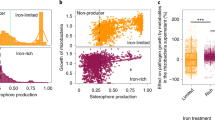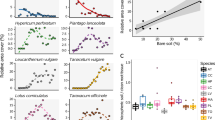Abstract
Host-associated microbiomes influence host health. However, it is unclear whether genotypic variations in host organisms influence the microbiome in ways that have adaptive consequences for the host. Here, we show that wild accessions of Arabidopsis thaliana differ in their ability to associate with the root-associated bacterium Pseudomonas fluorescens, with consequences for plant fitness. In a screen of 196 naturally occurring Arabidopsis accessions we identified lines that actively suppress Pseudomonas growth under gnotobiotic conditions. We planted accessions that support disparate levels of fluorescent Pseudomonads in natural soils; 16S ribosomal RNA sequencing revealed that accession-specific differences in the microbial communities were largely limited to a subset of Pseudomonadaceae species. These accession-specific differences in Pseudomonas growth resulted in enhanced or impaired fitness that depended on the host’s ability to support Pseudomonas growth, the specific Pseudomonas strains present in the soil and the nature of the stress. We suggest that small host-mediated changes in a microbiome can have large effects on host health.
This is a preview of subscription content, access via your institution
Access options
Subscribe to this journal
Receive 12 digital issues and online access to articles
$119.00 per year
only $9.92 per issue
Buy this article
- Purchase on Springer Link
- Instant access to full article PDF
Prices may be subject to local taxes which are calculated during checkout






Similar content being viewed by others
References
Gallo, R. L. & Hooper, L. V. Epithelial antimicrobial defence of the skin and intestine. Nature Rev. Immunol. 12, 503–516 (2012).
Berendsen, R. L., Pieterse, C. M. & Bakker, P. A. The rhizosphere microbiome and plant health. Trends Plant. Sci. 17, 478–486 (2012).
Bulgarelli, D. et al. Revealing structure and assembly cues for Arabidopsis root-inhabiting bacterial microbiota. Nature 488, 91–95 (2012).
Lundberg, D. S. et al. Defining the core Arabidopsis thaliana root microbiome. Nature 488, 86–90 (2012).
Salzman, N. H. et al. Enteric defensins are essential regulators of intestinal microbial ecology. Nat. Immunol. 11, 76–83 (2010).
Mukherjee, S. et al. Antibacterial membrane attack by a pore-forming intestinal C-type lectin. Nature 505, 103–107 (2014).
Badri, D. V., Chaparro, J. M., Manter, D. K., Martinoia, E. & Vivanco, J. M. Influence of ATP-binding cassette transporters in root exudation of phytoalexins, signals, and in disease resistance. Front. Plant Sci. 3, 149 (2012).
Jones, D. L., Nguyen, C. & Finlay, R. D. Carbon flow in the rhizosphere: carbon trading at the soil-root interface. Plant Soil 321, 5–33 (2009).
Rovira, A. D. Plant root exudates. Bot. Rev. 35, 35–57 (1969).
Lemanceau, P. et al. Effect of two plant species, flax (Linum usitatissinum L.) and tomato (Lycopersicon esculentum Mill.), on the diversity of soilborne populations of fluorescent Pseudomonads. Appl. Environ. Microbiol. 61, 1004–1012 (1995).
Germida, J. J., Sicilliano, S. D., de Freitas, J. R. & Arlette, M. S. Diversity of root-associated bacteria associated with field-grown canola (Brassica napus L.) and wheat (Triticum aestivum L.). FEMS Microbiol. Ecol. 26, 43–50 (1998).
Bouffaud, M. L., Poirier, M. A., Muller, D. & Moenne-Loccoz, Y. Root microbiome relates to plant host evolution in maize and other Poaceae. Environ. Microbiol. (2014).
Marschner, H., Römheld, V., Horst, W. J. & Martin, P. Root-induced changes in the rhizosphere: Importance for the mineral nutrition of plants. Z. Pflanz. Bodenkunde 149, 441–4456 (1986).
Couillerot, O., Prigent-Combaret, C., Caballero-Mellado, J. & Moenne-Loccoz, Y. Pseudomonas fluorescens and closely-related fluorescent pseudomonads as biocontrol agents of soil-borne phytopathogens. Lett. Appl. Microbiol. 48, 505–512 (2009).
Rodriguez, R. J. et al. Stress tolerance in plants via habitat-adapted symbiosis. ISME J. 2, 404–416 (2008).
Vacheron, J. et al. Plant growth-promoting rhizobacteria and root system functioning. Front. Plant Sci. 4, 356 (2013).
Weller, D. M. et al. Induced systemic resistance in Arabidopsis thaliana against Pseudomonas syringae pv. tomato by 2,4-diacetylphloroglucinol-producing Pseudomonas fluorescens. Phytopathology 102, 403–412 (2012).
Pieterse, C. M. et al. A novel signaling pathway controlling induced systemic resistance in Arabidopsis. Plant Cell 10, 1571–1580 (1998).
Li, H. et al. The use of Pseudomonas fluorescens P13 to control sclerotinia stem rot (Sclerotinia sclerotiorum) of oilseed rape. J. Microbiol. 49, 884–889 (2011).
Jalili, F. et al. Isolation and characterization of ACC deaminase-producing fluorescent pseudomonads, to alleviate salinity stress on canola (Brassica napus L.) growth. J. Plant Physiol. 166, 667–674 (2009).
Pallai, R., Hynes, R. K., Verma, B. & Nelson, L. M. Phytohormone production and colonization of canola (Brassica napus L.) roots by Pseudomonas fluorescens 6–8 under gnotobiotic conditions. Can. J. Microbiol. 58, 170–178 (2012).
Brand, I . et al. Isolation and characterization of a superior potato root-colonizing Pseudomonas strain. in Proceedings of the International Workshop on Plant Growth Promoting Rhizobacteria. IOBC/WPRS Bulletin XIV/8 (eds Keel, C., Knoller, B. & De ´fago, G. ) 350–354 (1991).
Kamilova, F., Lamers, G. & Lugtenberg, B. Biocontrol strain Pseudomonas fluorescens WCS365 inhibits germination of Fusarium oxysporum spores in tomato root exudate as well as subsequent formation of new spores. Environ. Microbiol. 10, 2455–2461 (2008).
Bolwerk, A. et al. Interactions in the tomato rhizosphere of two Pseudomonas biocontrol strains with the phytopathogenic fungus Fusarium oxysporum f. sp. radicis-lycopersici. Mol. Plant Microbe Interact. 16, 983–993 (2003).
Simons, M. et al. Gnotobiotic system for studying rhizosphere colonization by plant growth-promoting Pseudomonas bacteria. Mol. Plant Microbe Interact. 9, 600–607 (1996).
Atwell, S. et al. Genome-wide association study of 107 phenotypes in Arabidopsis thaliana inbred lines. Nature 465, 627–631 (2010).
DeAngelis, K. M. et al. Selective progressive response of soil microbial community to wild oat roots. ISME J. 3, 168–178 (2009).
Weinert, N. et al. PhyloChip hybridization uncovered an enormous bacterial diversity in the rhizosphere of different potato cultivars: many common and few cultivar-dependent taxa. FEMS Microbiol. Ecol. 75, 497–506 (2011).
Bouffaud, M. L. et al. Is diversification history of maize influencing selection of soil bacteria by roots? Mol. Ecol. 21, 195–206 (2012).
Millet, Y. A. et al. Innate immune responses activated in Arabidopsis roots by microbe-associated molecular patterns. Plant Cell 22, 973–990 (2010).
Mammarella, N. D. et al. Apoplastic peroxidases are required for salicylic acid-mediated defense against Pseudomonas syringae. Phytochemistry, 112, 110–121 (2014).
Peng, X. et al. Constitutive expression of rice WRKY30 gene increases the endogenous jasmonic acid accumulation, PR gene expression and resistance to fungal pathogens in rice. Planta 236, 1485–1498 (2012).
Zheng, Z., Qamar, S. A., Chen, Z. & Mengiste, T. Arabidopsis WRKY33 transcription factor is required for resistance to necrotrophic fungal pathogens. Plant J. 48, 592–605 (2006).
Nonejuie, P., Burkart, M., Pogliano, K. & Pogliano, J. Bacterial cytological profiling rapidly identifies the cellular pathways targeted by antibacterial molecules. Proc. Natl Acad. Sci. USA 110, 16169–16174 (2013).
Lugtenberg, B. & Kamilova, F. Plant-growth-promoting rhizobacteria. Annu. Rev. Microbiol. 63, 541–556 (2009).
Zamioudis, C., Mastranesti, P., Dhonukshe, P., Blilou, I. & Pieterse, C. M. Unraveling root developmental programs initiated by beneficial Pseudomonas spp. bacteria. Plant Physiol. 162, 304–318 (2013).
Srivastava, S. et al. Gene expression profiling through microarray analysis in Arabidopsis thaliana colonized by Pseudomonas putida MTCC5279, a plant growth promoting rhizobacterium. Plant Signal. Behav. 7, 235–245 (2012).
Raaijmakers, J. M. et al. Dose-response relationships in biological control of Fusarium wilt of radish by Pseudomonas spp. Phytopathology 85, 1075–1081 (1995).
Pieterse, C. M. et al. Induced systemic resistance by beneficial microbes. Ann. Rev. Phytopathol. 52, 347–375 (2014).
Pieterse, C. M., van Wees, S. C., Hoffland, E., van Pelt, J. A. & van Loon, L. C. Systemic resistance in Arabidopsis induced by biocontrol bacteria is independent of salicylic acid accumulation and pathogenesis-related gene expression. Plant Cell 8, 1225–1237 (1996).
Eitas, T. K. & Dangl, J. L. NB-LRR proteins: pairs, pieces, perception, partners, and pathways. Curr. Opin. Plant Biol. 13, 472–477 (2010).
Qi, D. & Innes, R. W. Recent advances in plant NLR structure, function, localization, and signaling. Front. Immunol. 4, 3483 (2013).
Meng, X. & Zhang, S. MAPK cascades in plant disease resistance signaling. Ann. Rev. Phytopathol. 51, 245–266 (2013).
Wu, L., Chen, H., Curtis, C. & Fu, Z. Q. Go in for the kill: How plants deploy effector-triggered immunity to combat pathogens. Virulence 5, 710–721 (2014).
Caporaso, J. G. et al. QIIME allows analysis of high-throughput community sequencing data. Nature Methods 7, 335–336 (2010).
Kerr, M. K. Linear models for microarray data analysis: hidden similarities and differences. J. Comput. Biol. 10, 891–901 (2003).
Daudi, A. et al. The apoplastic oxidative burst peroxidase in Arabidopsis is a major component of pattern-triggered immunity. Plant Cell 24, 275–287 (2012).
Diener, A. C. & Ausubel, F. M. RESISTANCE TO FUSARIUM OXYSPORUM 1, a dominant Arabidopsis disease-resistance gene, is not race specific. Genetics 171, 305–321 (2005).
Acknowledgements
C.H.H. is funded by MGH Toteston and Fund for Medical Discovery Fellowship grant 2014A051303 and previously by the Gordon and Betty Moore Foundation through Grant GBMF 2550.01 to the Life Sciences Research Foundation. B.S.S. was funded by a Charles King Trust Sr. Postdoctoral Fellowship. This work was supported by NIH R37 grant GM48707 and NSF grants MCB-0519898 and IOS-0929226 awarded to F.M.A. We thank J. Meyer, D. McEwan, J. Griffitts and L. Shapiro for critical reading of the manuscript and A. Diener and members of the Ausubel Lab for helpful comments and discussion.
Author information
Authors and Affiliations
Contributions
C.H.H. and F.M.A. conceived experiments and discussed results. C.H.H. and J.B. designed assays and performed experiments. B.S.S. and C.H.H. analysed data. C.H.H. wrote the manuscript with input from F.M.A., J.B. and B.S.S.
Corresponding author
Ethics declarations
Competing interests
The authors declare no competing financial interests.
Rights and permissions
About this article
Cite this article
Haney, C., Samuel, B., Bush, J. et al. Associations with rhizosphere bacteria can confer an adaptive advantage to plants. Nature Plants 1, 15051 (2015). https://doi.org/10.1038/nplants.2015.51
Received:
Accepted:
Published:
DOI: https://doi.org/10.1038/nplants.2015.51
This article is cited by
-
A novel plant growth-promoting rhizobacterium, Rhizosphaericola mali gen. nov., sp. nov., isolated from healthy apple tree soil
Scientific Reports (2024)
-
Bacterial community and culturable actinomycetes of Phyllostachys viridiglaucescens rhizosphere
Antonie van Leeuwenhoek (2024)
-
Pioneer Arabidopsis thaliana spans the succession gradient revealing a diverse root-associated microbiome
Environmental Microbiome (2023)
-
The Arabidopsis holobiont: a (re)source of insights to understand the amazing world of plant–microbe interactions
Environmental Microbiome (2023)
-
PSKR1 balances the plant growth–defence trade-off in the rhizosphere microbiome
Nature Plants (2023)



